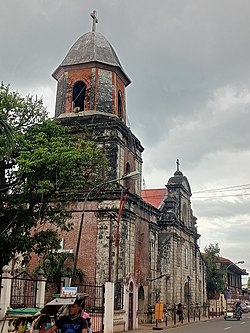Hinigaran | |
|---|---|
| Municipality of Hinigaran | |
 St. Mary Magdalene Parish Church, Hinigaran | |
| Nicknames: "The Oyster and Pyrotechnics Capital of Negros Occidental" "Christmas Capital of Negros Occidental" "Center of Economic Development by 2030" | |
 Map of Negros Occidental with Hinigaran highlighted | |
 Interactive map of Hinigaran | |
Location within the Philippines | |
| Coordinates: 10°16′N122°51′E / 10.27°N 122.85°E | |
| Country | Philippines |
| Region | Negros Island Region |
| Province | Negros Occidental |
| District | 5th district |
| Founded | 1768 |
| Barangays | 24 (see Barangays) |
| Government | |
| • Type | Sangguniang Bayan |
| • Mayor | Mary Grace S. Arceo (NPC) |
| • Vice Mayor | Jose Nadie P. Arceo (NPC) |
| • Representative | Emilio Bernardino L. Yulo III (Lakas) |
| • Municipal Council | Members |
| • Electorate | 55,682 voters (2025) |
| Area | |
• Total | 154.92 km2 (59.81 sq mi) |
| Elevation | 5.0 m (16.4 ft) |
| Highest elevation | 43 m (141 ft) |
| Lowest elevation | 0 m (0 ft) |
| Population (2024 census) [3] | |
• Total | 90,403 |
| • Density | 583.55/km2 (1,511.4/sq mi) |
| • Households | 22,592 |
| Demonyms | Hiligaynon (Ilonggo): Hinigaranon (masculine) Hinigareno (feminine) Hinigarena |
| Economy | |
| • Income class | 1st municipal income class |
| • Poverty incidence | 19.65 |
| • Revenue | ₱ 410.7 million (2022) |
| • Assets | ₱ 912.3 million (2022) |
| • Expenditure | ₱ 340 million (2022) |
| • Liabilities | ₱ 369.6 million (2022) |
| Service provider | |
| • Electricity | Negros Occidental Electric Cooperative (NOCECO) |
| • Water | Hinigaran Municipal Water Enterprise |
| Time zone | UTC+8 (PST) |
| ZIP code | 6106 |
| PSGC | |
| IDD : area code | +63 (0)34 |
| Languages | Hiligaynon Tagalog English |
| Website | www |
Hinigaran, officially the Municipality of Hinigaran (Hiligaynon : Banwa sang Hinigaran; Tagalog : Bayan ng Hinigaran), is a municipality in the province of Negros Occidental, Philippines. According to the 2024 census, it has a population of 90,403 people. [5]
Contents
- Etymology
- History
- Geography
- Barangays
- Climate
- Demographics
- Languages
- Economy
- Economic Profile
- Infrastructure
- Healthcare
- Media
- FM radio stations
- Education
- Notable personalities
- References
- External links
It is the fastest growing economy and progressive development in the province of Negros Occidental. Hinigaran envision itself to be leading of top economic hub place for commerce, industry and, education in the southern district. It is also aim to become a "Center of Economic Development" by 2030 in the south-central part of Negros Occidental.
Hinigaran is currently applying for Independent Component City (ICC).



